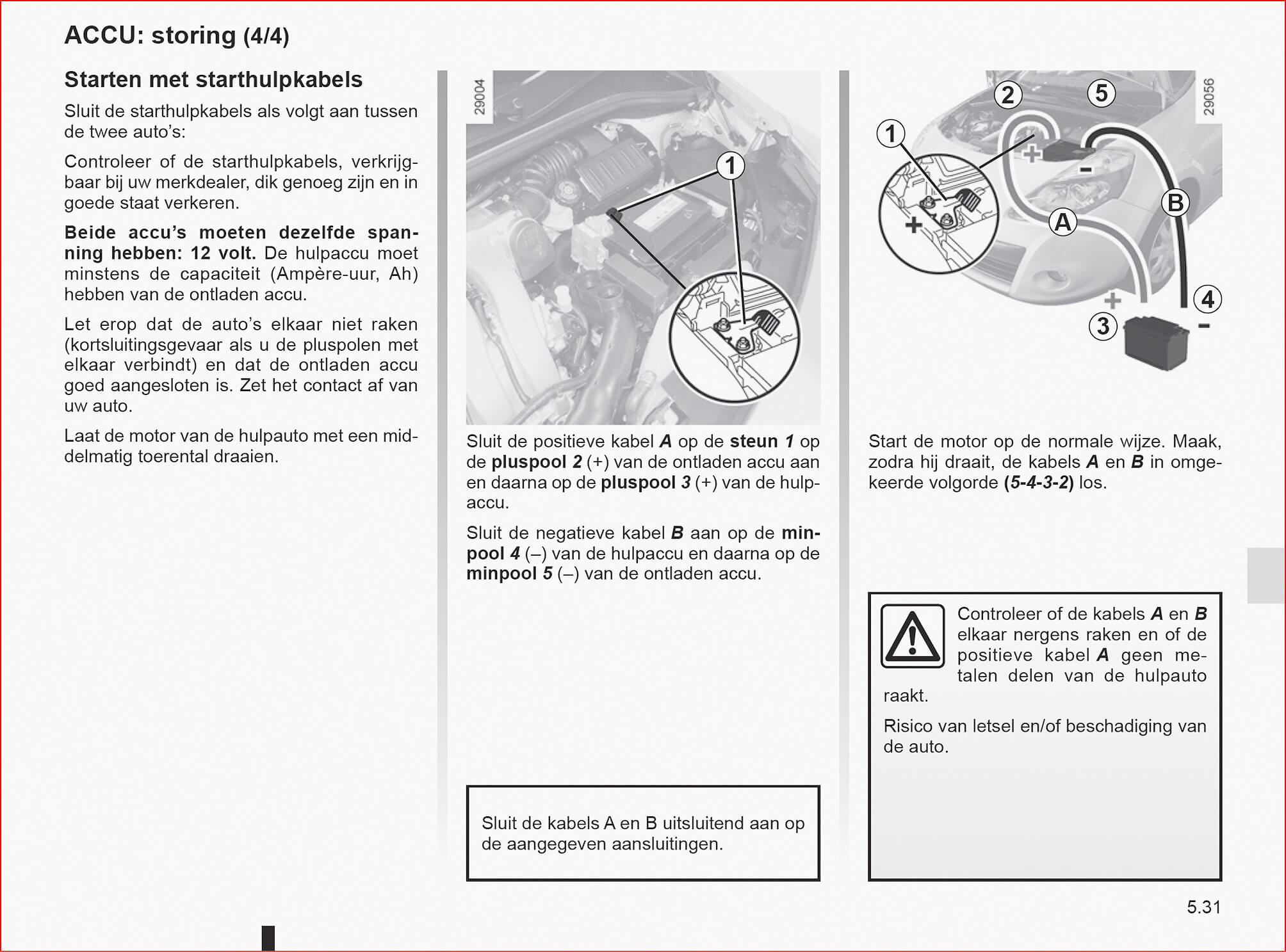What constitutes a ‘document’ and how does it function?
According to the Oxford English Dictionary, the etymological origin is the Latin ‘documentum’, meaning ‘lesson, proof, instance, specimen’. As a verb, it is ‘to prove or support (something) by documentary evidence’, and ‘to provide with documents’. The online version of the OED includes a draft addition, whereby a document (as a noun) is ‘a collection of data in digital form that is considered a single item and typically has a unique filename by which it can be stored, retrieved, or transmitted (as a file, a spreadsheet, or a graphic)’. The current use of the noun ‘document’ is defined as ‘something written, inscribed, etc., which furnishes evidence or information upon any subject, as a manuscript, title-deed, tomb-stone, coin, picture, etc.’ (emphasis added).
Both ‘something’ and that first ‘etc.’ leave ample room for discussion. A document doubts whether it functions as something unique, or as something reproducible. A passport is a document, but a flyer equally so. Moreover, there is a circular reasoning: to document is ‘to provide with documents’. Defining (the functioning of) a document most likely involves ideas of communication, information, evidence, inscriptions, and implies notions of objectivity and neutrality – but the document is neither reducible to one of them, nor is it equal to their sum. It is hard to pinpoint it, as it disperses into and is affected by other fields: it is intrinsically tied to the history of media and to important currents in literature, photography and art; it is linked to epistemic and power structures. However ubiquitous it is, as an often tangible thing in our environment, and as a concept, a document deranges.
the-documents.org continuously gathers documents and provides them with a short textual description, explanation,
or digression, written by multiple authors. In Paper Knowledge, Lisa Gitelman paraphrases ‘documentalist’ Suzanne Briet, stating that ‘an antelope running wild would not be a document, but an antelope taken into a zoo would be one, presumably because it would then be framed – or reframed – as an example, specimen, or instance’. The gathered files are all documents – if they weren’t before publication, they now are. That is what the-documents.org, irreversibly, does. It is a zoo turning an antelope into an ‘antelope’.
As you made your way through the collection,
the-documents.org tracked the entries you viewed.
It documented your path through the website.
As such, the time spent on the-documents.org turned
into this – a new document.
This document was compiled by ____ on 21.09.2022 20:06, printed on ____ and contains 22 documents on _ pages.
(https://the-documents.org/log/21-09-2022-4593/)
the-documents.org is a project created and edited by De Cleene De Cleene; design & development by atelier Haegeman Temmerman.
the-documents.org has been online since 23.05.2021.
- De Cleene De Cleene is Michiel De Cleene and Arnout De Cleene. Together they form a research group that focusses on novel ways of approaching the everyday, by artistic means and from a cultural and critical perspective.
www.decleenedecleene.be / info@decleenedecleene.be - This project was made possible with the support of the Flemish Government and KASK & Conservatorium, the school of arts of HOGENT and Howest. It is part of the research project Documenting Objects, financed by the HOGENT Arts Research Fund.
- Briet, S. Qu’est-ce que la documentation? Paris: Edit, 1951.
- Gitelman, L. Paper Knowledge. Toward a Media History of Documents.
Durham/ London: Duke University Press, 2014. - Oxford English Dictionary Online. Accessed on 13.05.2021.

As an architectural structure, the pier is fundamental in observational astronomy: it can be found in the backyards of amateur observatories, as well as in professional ones. This column is a quintessential part of the physical interventions that are necessary to distinguish noise from valuable data. The pier disjoints the telescope from the observer, from the observatory and from the surroundings. Tremors of passing cars, the astronomer’s footsteps and coughs, the neighbour’s soundsystem: they could result in an agitated telescope. A falling mug would cause the instrument to shift lightyears away from its target.
In August 2019, I visited Chris De Pauw, an astrophotographer, at home. He showed me his private observatory. As we were both waiting for clouds to obscure the sun and get softer light for the photograph, he told me about the rolling shed, its advantages and the modifications he was planning on.
On closing the observatory – by rolling the shed over the instrument – he manoeuvred the instrument into its ‘park’-position: an azimuth of 160 degrees and an elevation of 8 degrees above the horizon. The shed’s doors and hinges barely cleared the telescope.

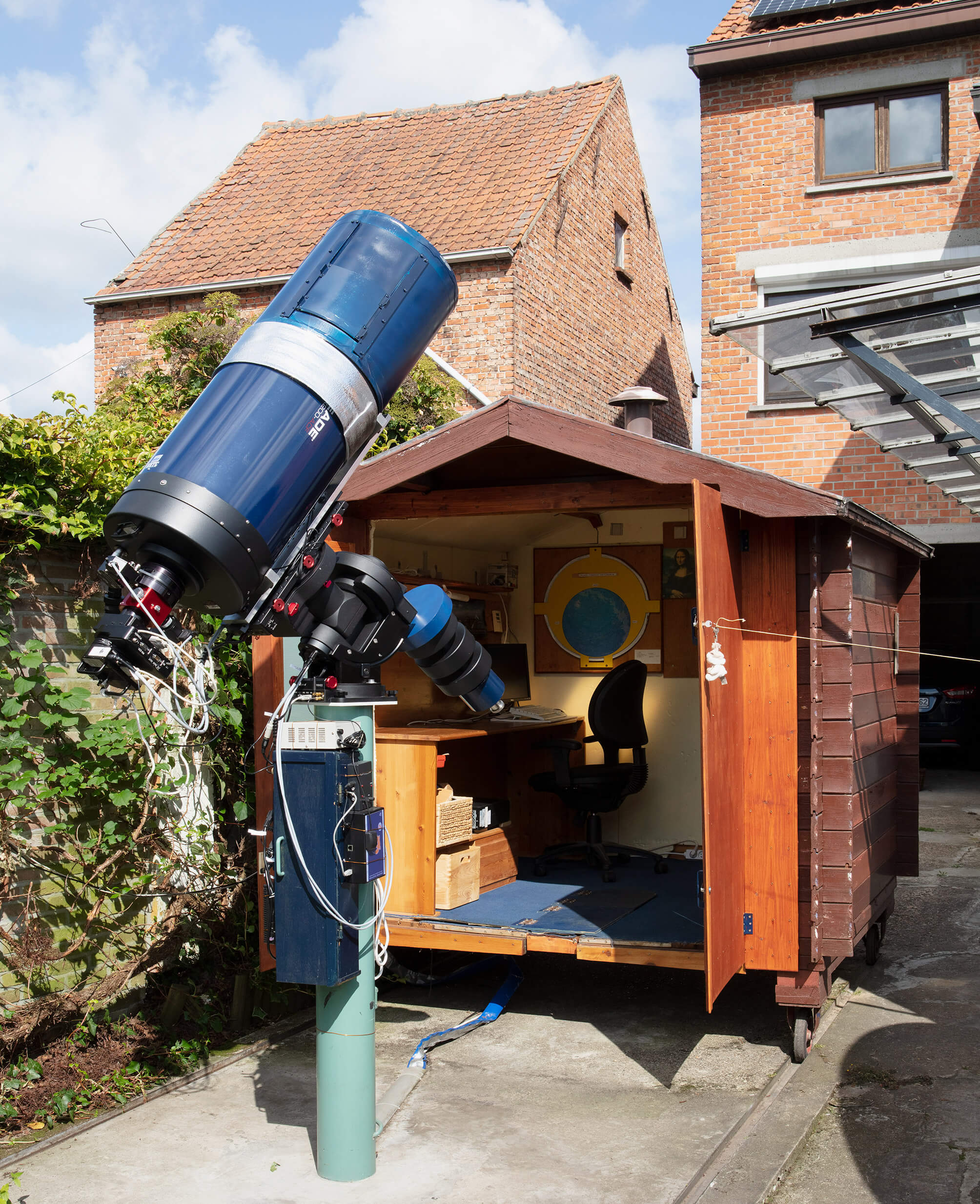
According to art critic Rosalind Krauss, nineteenth-century stereographic images presented ‘views’, not ‘landscapes’. Looking at a stereographic image through a stereoscope involves a particular experience that is altogether different from looking at other types of photographs, or paintings, as it is defined by ‘the isolation of the viewer with an image from which surrounding interference is masked out‘.1 An image of a violent and sudden eruption, higher up on the mountain, hanging next to a stereographic image of a petrified lava flow, would not be perceived.
Krauss, R. The Originality of the Avant-Garde and Other Modernist Myths. Cambridge, Mass./London: The MIT Press, 1986, 139.

During the night, both of us get unwell. One of us is shaking, intensely and relentlessly. The windows are open. For minutes that seem to be hours, it feels like it’s freezing. We get extra blankets. Then, it gets too hot.
One of us dreams about coccodrillos. It starts out with a single animal, like the one we saw in the National Archaeological Museum, escaping from an aquarium, and ends with lots of little ones crawling all over the place. It’s impossible to know how many have escaped.
The other dreams about seismologist Luigi Palmieri’s unfortunate assistant and his family’s quest to redeem his good name. To deprive him of the burden and guilt set upon him by Luigi Palmieri’s report of the 1872 eruption of Vesuvius, the assistant’s offspring were building a monument just below the observatory in which their great-grandfather fell asleep. The monument was permanently, and continuously, unfinished.
We both dream of hearing fireworks in Naples.
In the morning, we’re slightly alarmed that we both got sick and feverish at the same instant. It’s the middle of January, and the weather has been summerlike all week. A gentle morning breeze flies in from the Neapolitan bay while we wait for the bus to take us to the airport.
First published as part of De Cleene De Cleene. ‘Amidst the Fire, I Was Not Burnt’, Trigger (Special issue: Uncertainty), 2. FOMU/Fw:Books, 25-30

December, 1947. Rapid snowmelt coincides with torrential precipitation. At the bottom of the Thur valley, in Wildenstein, the water gathers.
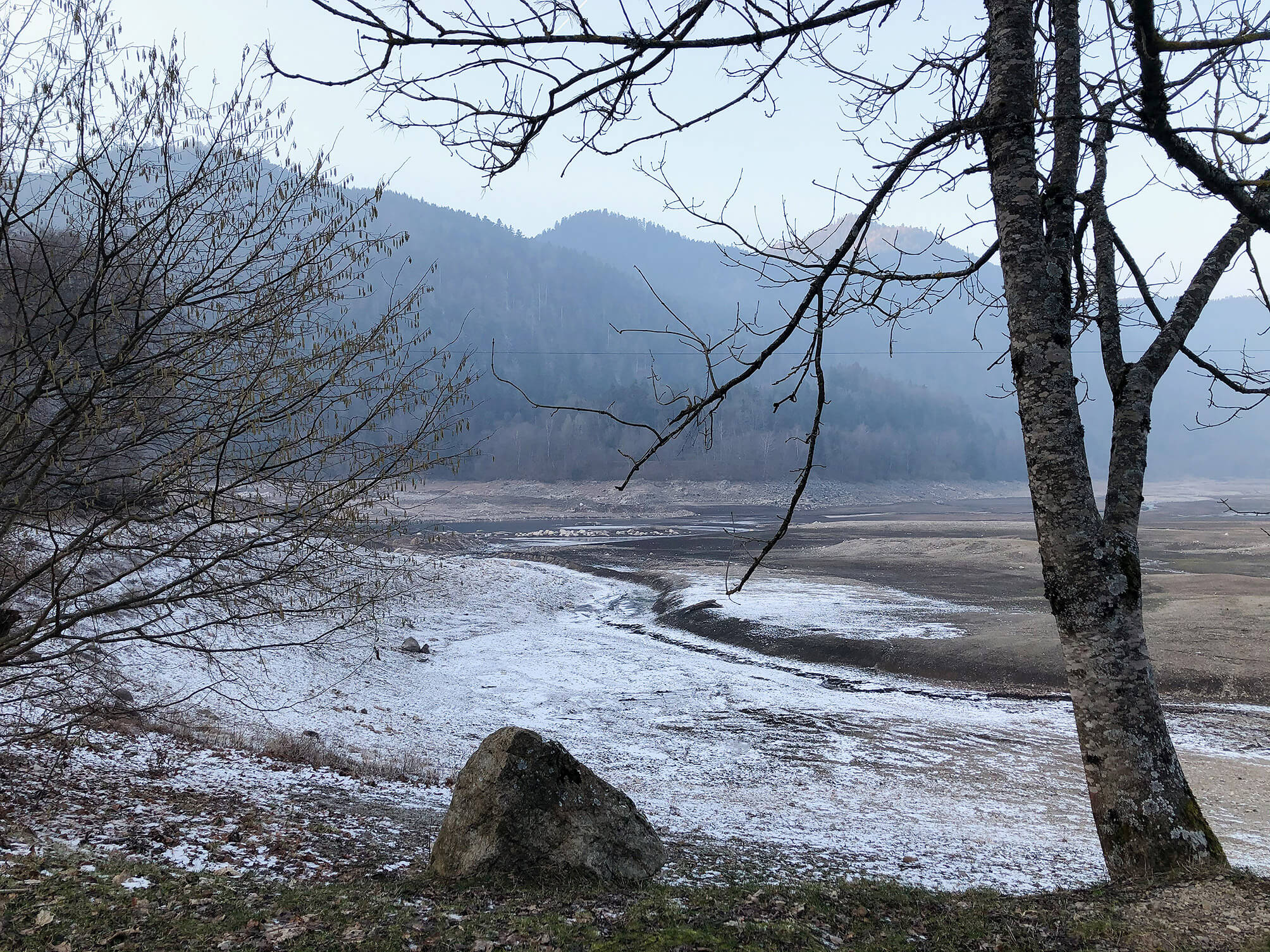
A skiing holiday with my in-laws. The ski pass does not allow you to visit Schatzalp. We buy a separate ticket and take the train up the hill to the hotel, which served as the backdrop for Thomas Mann’s Magic Mountain. The stately hotel and former sanatorium is gorgeous.
Meanwhile, a new virus is spreading. Some people are coughing. I am keeping distance while waiting in line to take the train back down to the snow-covered village.
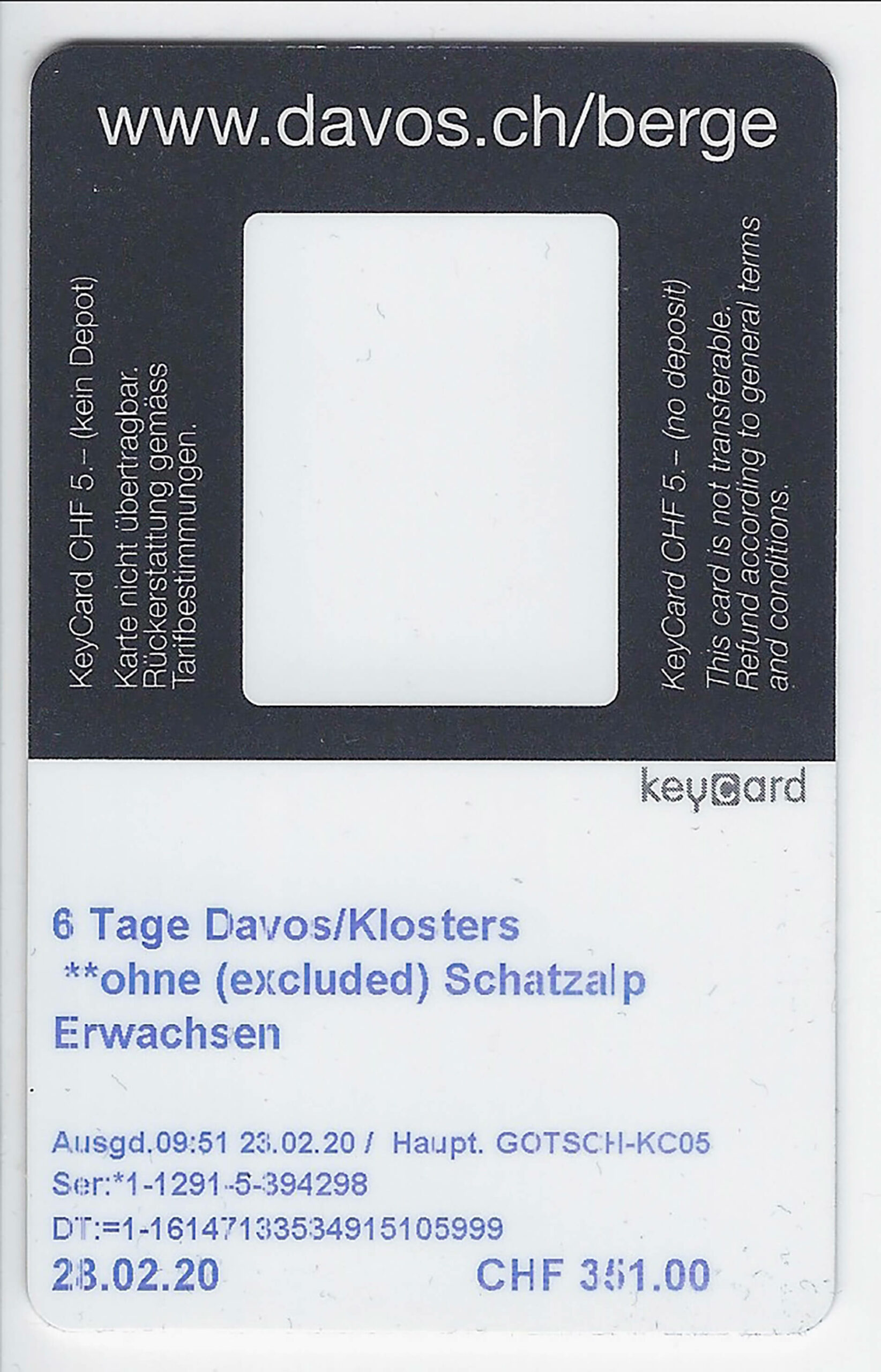
The paths in the valley of the Bayehon are covered with ice. We are making our way down towards the valley of the Ghâster. The temperature is minus 15 degrees Celsius. The water in our drinking bottles is frozen. We are betting on the shelter indicated on the map (Au Pied des Fagnes, Carte De Promenades, 1:25.000, Institut Geographique National) to pitch our tent. There is almost no wind, but every breath of air feels like we’re being hit with a thousand needles. What the map indicates as a shelter appears to be a picnic table.
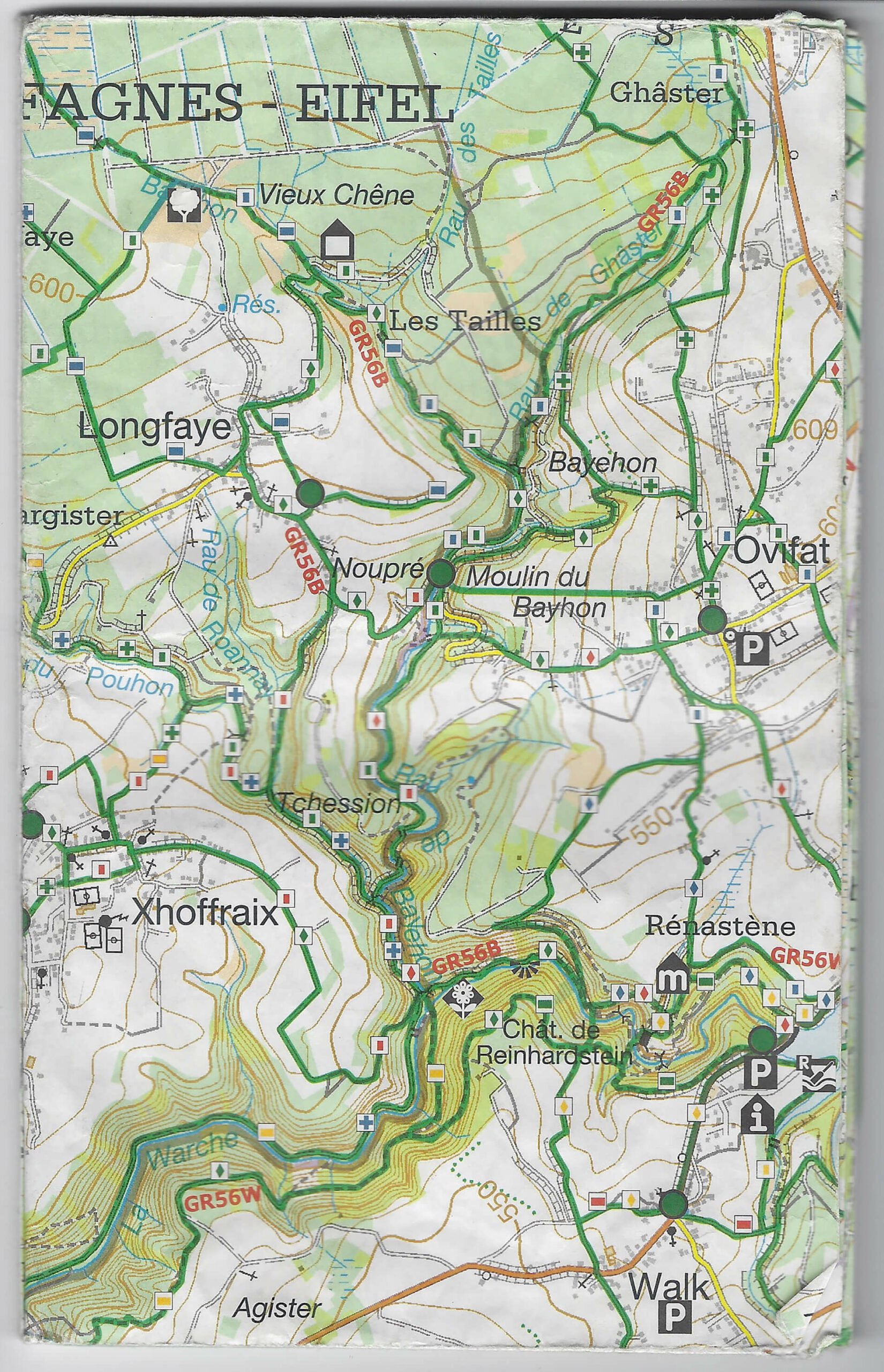
It’s 21:49 on Tuesday May 4th 2021. I’m sifting through the folders of a back-up drive. When I reach Archief2A/2017/wigny donder, the subfolder contains 103 items (97 DNG-files, 1 JPEG-file and 5 PSD-files). The photographs are all very similar. They show the silhouette of the same tree and hills, the red light of the telecommunications mast on the left and the orange glow of the street’s sodium lights. The thunderstorm moves from right to left. _44A3920 is the only exposure (10 seconds) that recorded lightning bolts.
I looked up heat lightning, also known as silent lightning, summer lightning, or dry lightning, which is simply cloud-to-ground lightning that occurs very far away, with thunder that dissipates before it reaches the observer. On YouTube I watched: Top 10 Dangerous Lightning Strikes Thunder recorded on Camera (HIGH VOLTAGE!!) followed by Lightning Strikes at the 2019 U.S. Women’s Open. It’s 22:07, I am doubtful at first but become convinced I can hear thunder afar.

‘Because there is a kind of technological beauty to it.’
[…]
‘Yes, a perfect combination of the analogous on the one hand, and a kind of state of the art-futuristic cool on the other hand. It was elegant (unlike audio-cassettes), you could see the disc upon which your music was written (unlike the unfathomable MP3), it was less fragile than a CD(-R), and conveniently sized (you could hold it in the palm of your hand, slip it into your pocket). It had a kind of Mission Impossible-esque gadget feel to it. It had the aura of being permanently ahead of its time, but not in a far-fetched sci-fi kind of way. It was real.’
[…]
‘You mean the clicks. Yes, it had a sound of its own. A pleasant sound – the hard plastic hitting the hard plastic sleeve. The slidable, uhm, metal thing. The small read/write handle at the side. The small disc that was just a little bit loose. It – without being played – looked, felt and sounded like, like data, yes, like palpable data.’
[…]
‘Not any more.’
[…]
‘My uncle’s Elvis Costello This Year’s Model LP with way too little bass-sounds. Watching the detectives, to be precise.’
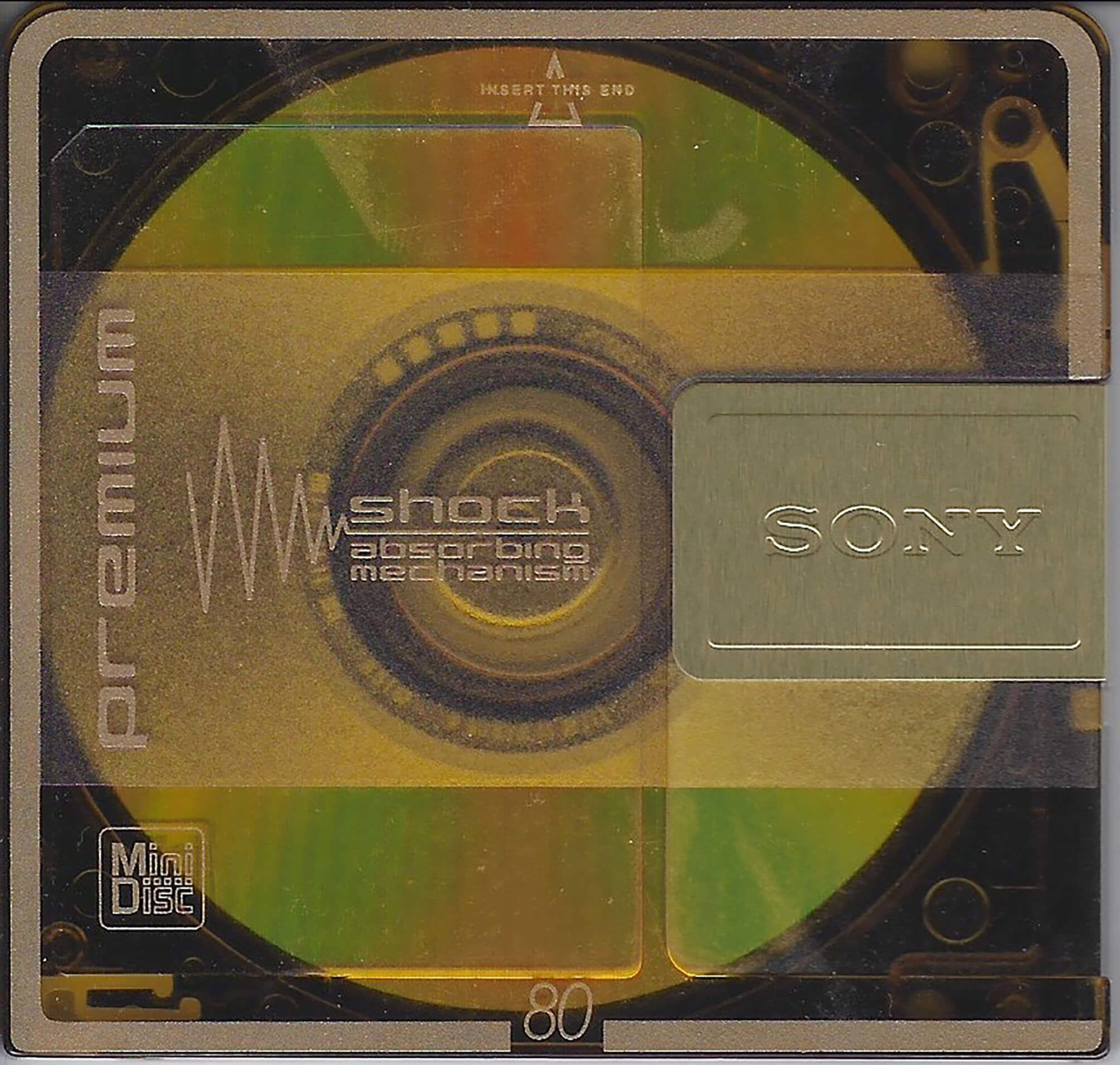
Seven very similar and rudimentary buildings take in a trapezoid plot of land in Gilly. They are located between the school on the Rue Circulaire and the houses along the Rue de l’Abbaye. The structures are built of orange brick, concrete structural elements, whitish steel gates and roofing. Every garage has its own number, hand-painted in white on the concrete lintel above each gate. In summer the roofing gets hot and soft.
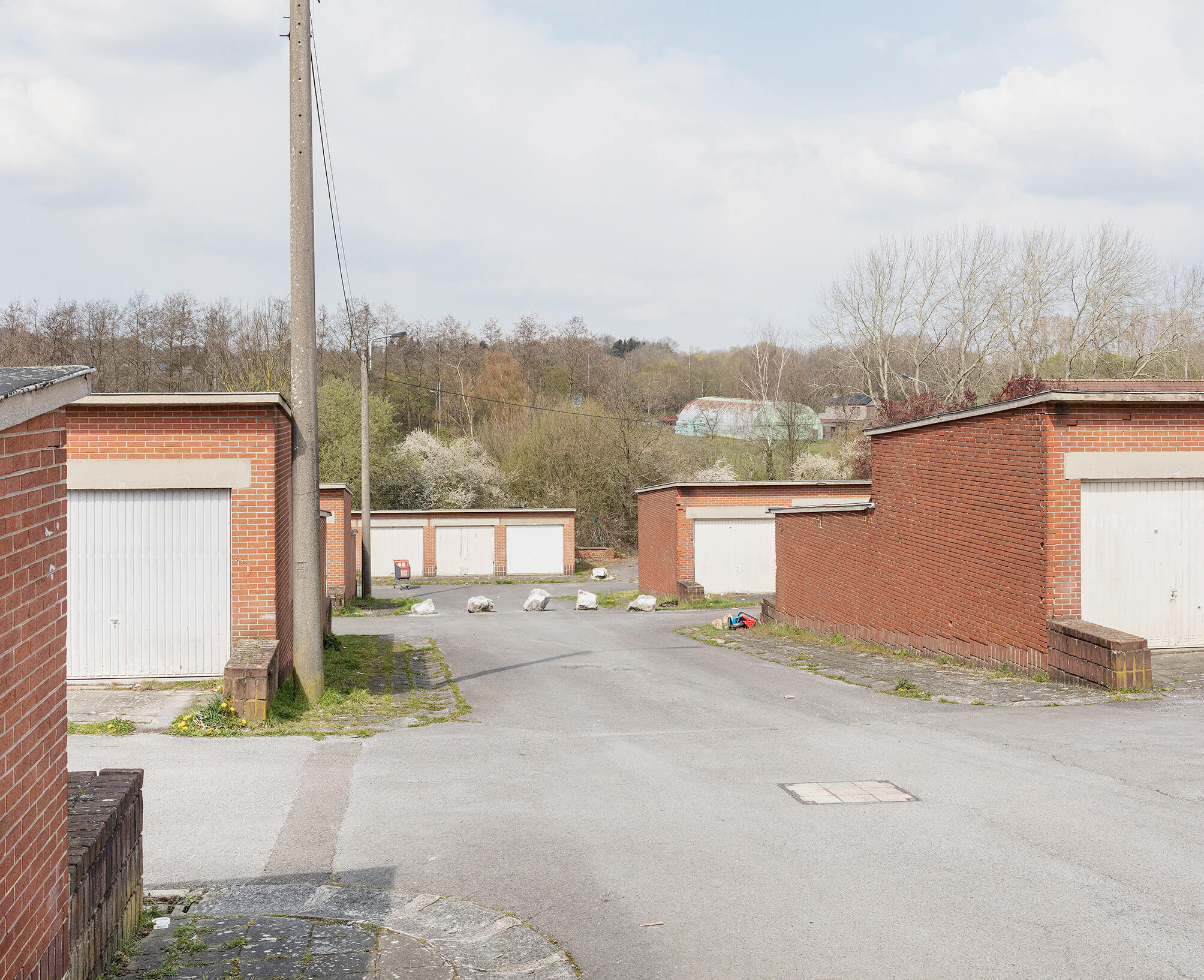
Until recently, for as long as I could remember, the packaging of Tabasco® Pepper Sauce had been unchanged. On the front of the packaging, there is a photograph of a bottle of Tabasco®, scale 1:1, against an orange background.As far as packaged goods go, this is a highly idiosyncratic and quirky example.
The background colour approximates the colour of the liquid inside the bottle, resulting in as good as no contrast. Moreover, as the image of the bottle is scale 1:1, the packaging becomes kind of unnecessary and superfluous, also because the life-sized image of the bottle is the only way information is given to the customer: there are no additional slogans, no repetition of the brand name, no props and no decor. The image of the bottle advertises the bottle. It seems to add nothing the bottle could not do by its own (like a bottle of wine does).
What makes the packaging truly stand out, however, is the fact that the image of the bottle is not positioned vertically, but is slightly askew. It seems to be the result of a design error, and has an amateur feel to it. The decision to keep it as such and not correct it up until today, is, however, a stroke of genius. The non-vertical positioning alters the relation of the image of the bottle to the bottle inside: as the box is standing on a shelf, the tilted image of the bottle undermines its representational superfluousness.

September 2020, three days before Neptune is in opposition, I meet Frédéric on top of a hill in Luxembourg.
Earlier that day he had sent me the coordinates of an airfield for remote controlled aeroplanes. He told me to meet him there at 20h. The airfield is situated on the top of a hill, granting a clear view of the horizon. Removed from highways and city centres, only the southern horizon lights up, where the Grand Duchy’s capital is located, some 15 kilometres farther. The weather is promising: ‘We might get a chance to see and photograph Neptune!’ he wrote.
I get there early. Frédéric is already setting up his tripod. Two elderly men are training for the perfect landing.

When the Sun, the Earth and one of the outer planets of the Solar System perfectly align, with the Earth positioned in the middle, the outer planet is said to be ‘in opposition’. It’s a moment of planetary approach and of optimal viewing conditions: the Earth and the outer planet are at their closest and brightest.
Neptune in opposition [1-20] is part of ‘Documenting Objects’, a research project by Arnout De Cleene and Michiel De Cleene at KASK & Conservatorium, the school of arts of HOGENT and Howest. Their research is financed by the HOGENT Arts Research Fund. Previous research into this subject has amongst other things led to the documentary film Towards Civil Dusk (2020) and temporary public observatories at 019, Gent and Kunsthal Extra City, Antwerp.

Here, on his kitchen table, Marcel Poulet, an expert on the stoneware tradition in the center of France, is explaining his archeological work on ‘whale ovens’.
I started collecting images and plans of ovens, for the beauty of those abstract technical lines and for what we can learn from them. In gathering the material that makes up this Atlas, and in sharing interests and knowledge, I learned that many people know about ovens, either in their homes, gardens, ateliers, factories, streets… Everyone transforms things through heat. Even bodies need warmth and produce some themselves.
Clementine Vaultier’s interests, although trained as a ceramist, are in the warm surroundings of the fire rather than the production it engenders.

This stack of seaweed was offered by Henning, a farmer of the wonderful island of Laeso. This matriarchal pirate island, north of Denmark, is known for its tradition of building roofs from the seaweed growing in the surrounding salty water. Back in time, women would harvest and slowly weave the material around wooden beams from shipwrecks. This time-consuming process and technique of building shelters from what comes from the sea engaged the population in working together, building a ritual around each construction. Then those wild, yet full-of-care roofs, conserved in salt, would last for hundreds of years.
When I arrived on his land, Henning told me about how he restores those old beauties, weaving fresh seaweed around old beams and pressing the collected old material into insulation panels for new buildings. We talked about the clay of his land and how seaweed can become a material for ceramics in the process of making glazes.
Clementine Vaultier’s interests, although trained as a ceramist, are in the warm surroundings of the fire rather than the production it engenders.

For about an hour, he has been saying ‘owl’ at regular intervals. A cartoon character he picked up somewhere and is now fantasizing about, I guess. Or a Disney reference in one of the songs that have been playing on repeat all day, in the car, driving home from holidays.
50 kilometers further, I recognize the birds in the high-voltage pylons along the highway.
According to the amateur experts at hoogspanningsforum.com, these French pylons – used for conducting electricity from 63kV to 400kV – are nicknamed ‘chats’: the wiring can be interpreted as feline whiskers.
Some genera of owls, such as the Megascops or Screech owls, have whiskers.

At the end of the day, riding home after work, I find a text on my hand:
C
D[…]ers
Desk
K
Communication book
‘Diapers’, I recall, and stop at the shop to buy them. Sweat, dust, and manic hand rubbing have rendered parts of the writing illegible. ‘C’ is for Carl, whose newborn I need to visit as soon as possible. Sometimes, I can’t remember what the initial stands for. I don’t have any friends with names beginning with a K (who have newborns I need to visit).
The right hand writes, the left hand serves as the canvas. The back of the right hand, folded around the pen, is blank and tells the always already written on back of the left hand, whose palm never holds a pen, what to register. Right: an author. Left: a poem, sunken into the pores.
Back home, I trace ‘Desk’ again, as not to forget to clean it tomorrow.
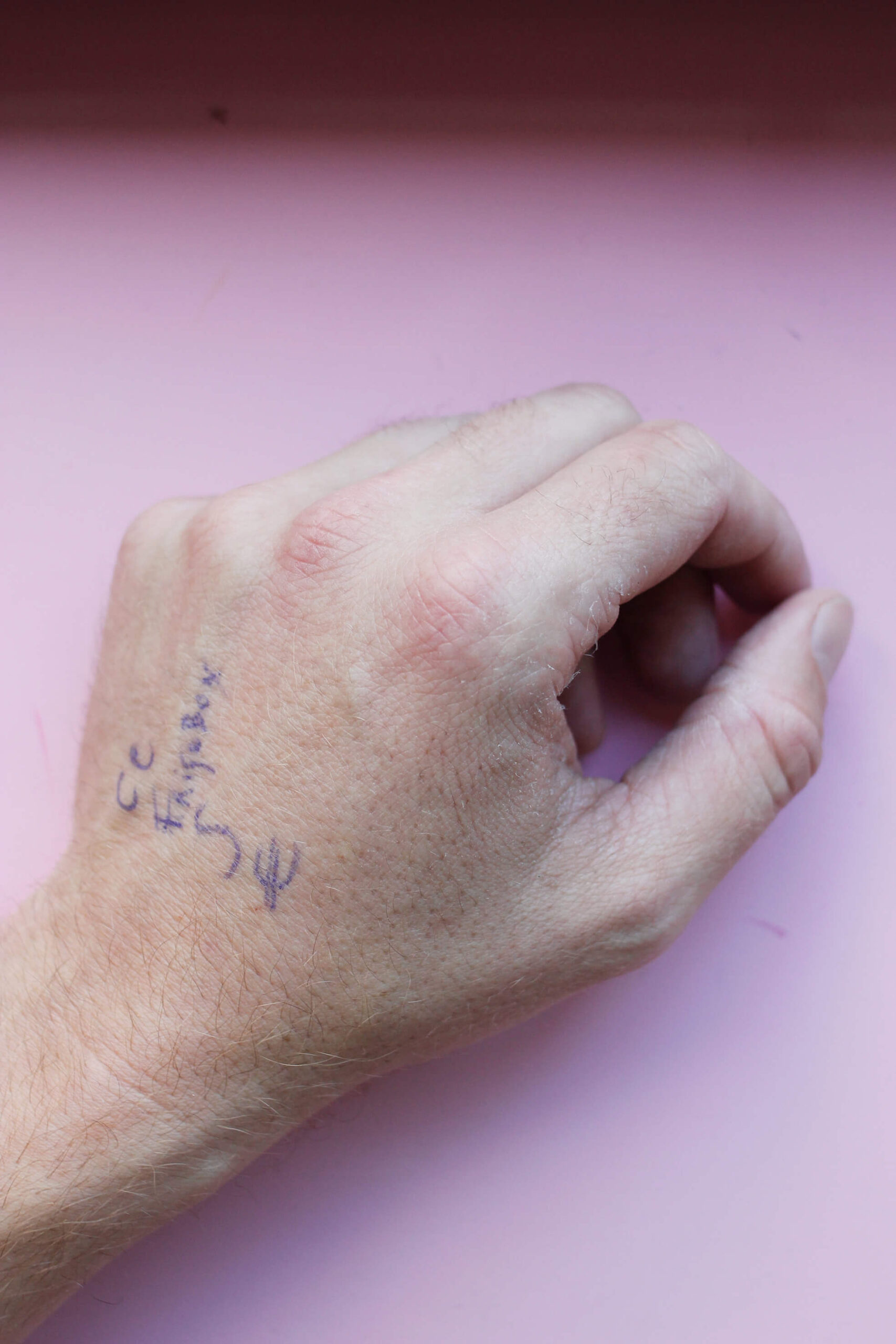

At the beach of Cap d’Antifer in Normandy one can find ‘sea glass’ between the pebbles: pieces of broken glass that have naturally weathered by being tumbled by the ocean, over and over. Sharp edges and smooth surfaces vanish. The historical origin of the glass pebbles (glass bottles, a shipwreck) erodes. Only the colour of the pebbles gives an indication of their history, be it vaguely. Varieties of green sea glass are common, but other colours, such as red (Shlitz beer bottles) or yellow (interbellum Vaseline containers), are more rare and have to be sought after attentively.
It’s 4.15 PM. The tide is pushing three people towards the cliffs.

The GPS-plotter displays the ship near Keyhaven Lake, indefinitely. The sea appears calm, the horizon is level from one perspective.
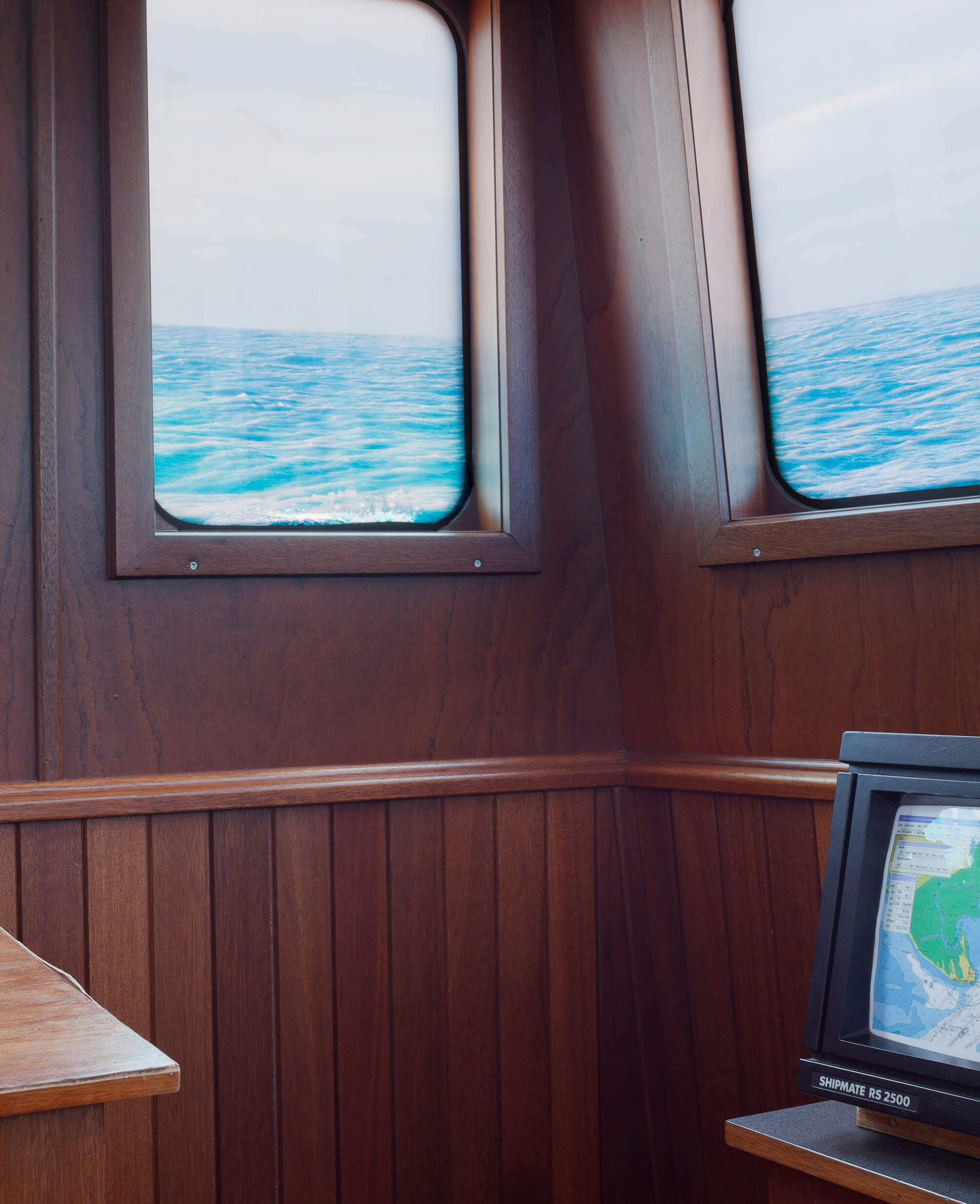
At a dental practice, the white Alligat®-powder is mixed with the right amount of water to get a mouldable dough that is pressed upon a patient’s teeth. After thirty seconds, the Alligat®-dough stiffens and takes on a rubber-like quality. At that point, still white, it must be removed from the patient’s mouth. Over the next few hours, the mould turns increasingly pink as the substance becomes less humid. Now, it can be used as a mould to create a positive master cast of the patient’s teeth.
Outside the dental practice, the powder’s possibilities remain to be fully explored.

First published as part of De Cleene De Cleene. ‘Amidst the Fire, I Was Not Burnt’, Trigger (Special issue: Uncertainty), 2. FOMU/Fw:Books, 25-30
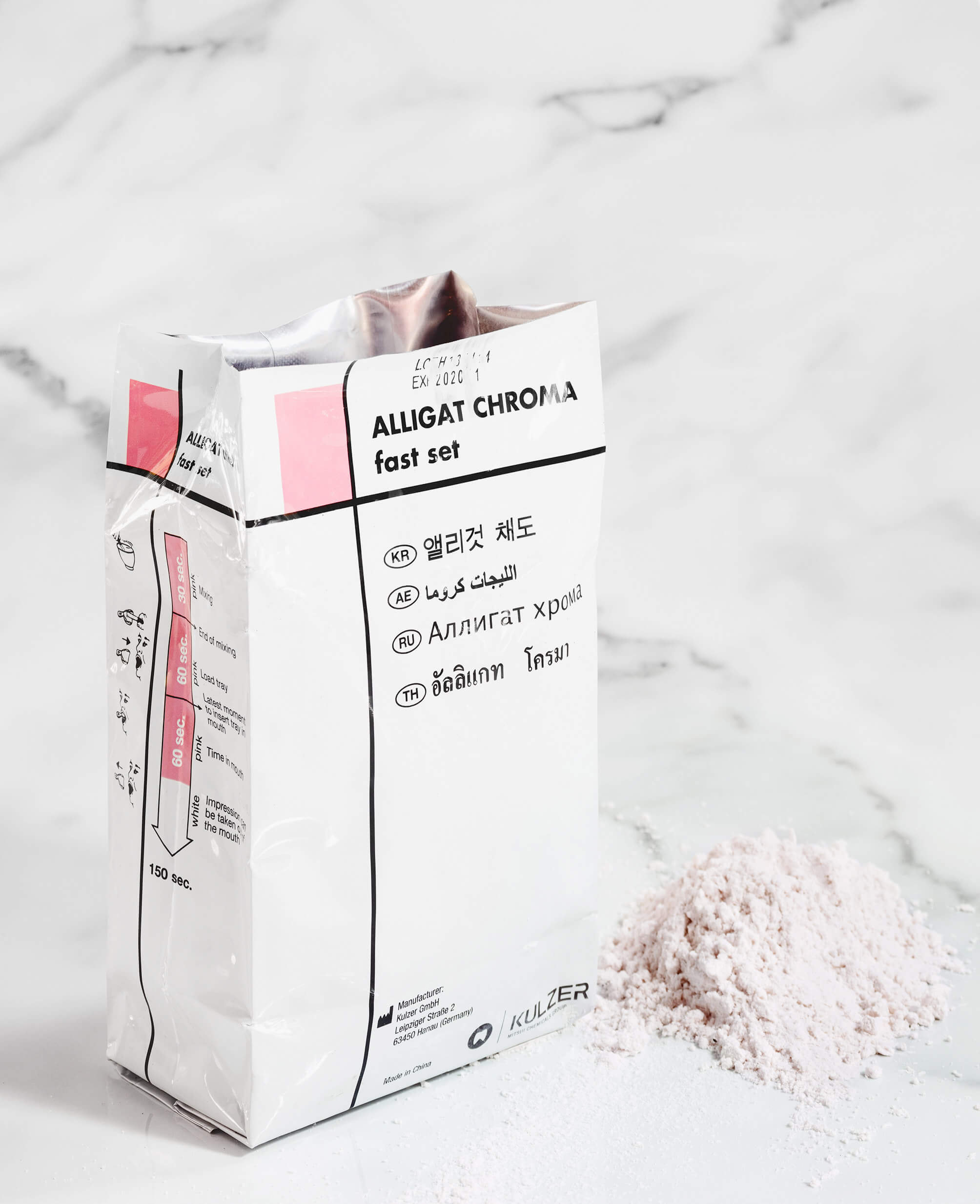
The archive of O. Clemminck, architect, was preserved in a box of croutons – by him, the historian who gave it to my father, or someone else (it contains a letter written by Clemminck’s widow asking a client to pay the bill her husband had sent). The croutons had a flavor of fine herbs and, a stamp on the box with the plans in it says, should have been consumed before April 1987.
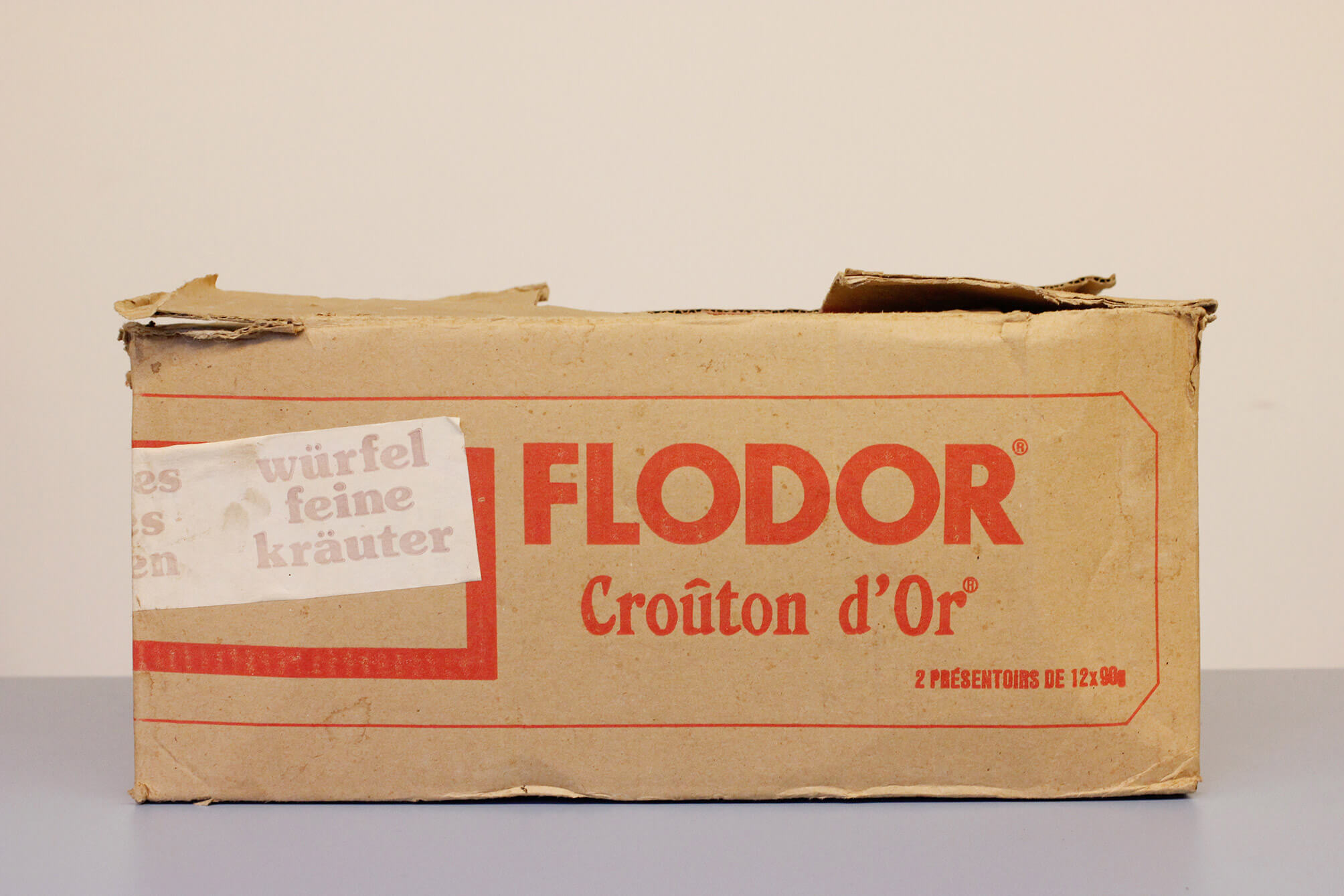
A 250 meter walk away from the seaside. A sign states in Dutch and French:
‘!!! NO PARKING !!!
Wrongly parked cars will be chained and only released upon payment of a € 40 parking fee’
The 40 EUR parking fee the sign threatens to charge is communicated by a relatively new sticker stuck on an older sign. Underneath the three black characters (€, 4 and 0) on a white background, there’s a relief: 7 characters declaring a parking fee of 1500 BEF.
1500 BEF equals 37,18 EUR1. In changing currency, the fee increased by 7,58%.
The Belgian franc was the currency of the Kingdom of Belgium from 1832 until 2002 when the Euro was introduced. 1 EUR is worth 40,3399 BEF.
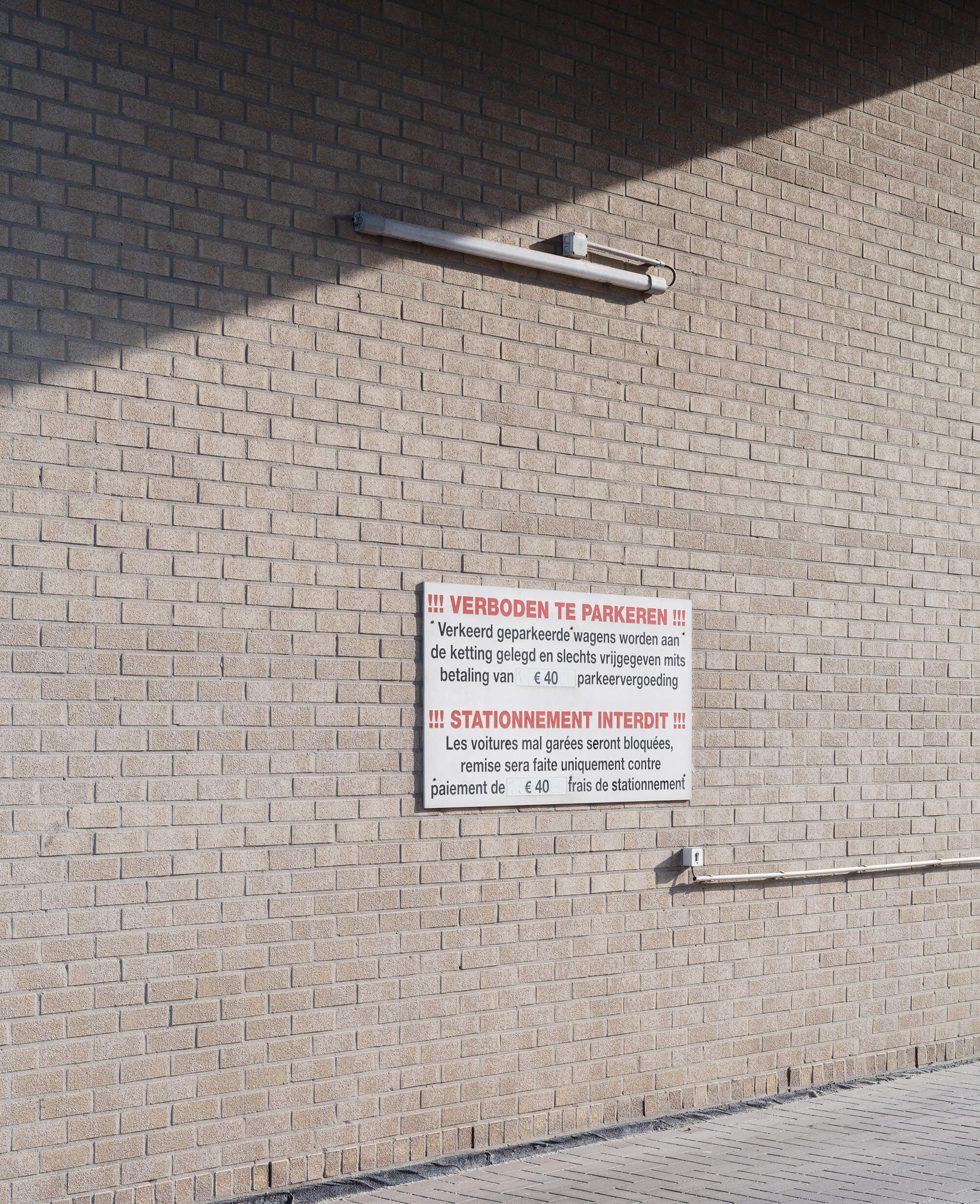
Due to strict regulations during the COVID-19-pandemic, the yearly vehicle inspection had to be scheduled by appointment. Getting ready to drive to the DMV, the car wouldn’t start. It had rained heavily, the preceding days. The day before the DMV-appointment, water had come running into the car on pushing the pedals. My socks were wet.
I called the DMV to say I needed to cancel the appointment and make a new one (but that the car, besides not being able to drive, was perfectly fine, vehicle-inspection-wise).
Later that day, we got the engine up and running again, using jumper cables and a second car, so we would be able to drive to meet the midwife the next day.
Renault Clio. Instructieboekje. 2012. PDF-file
